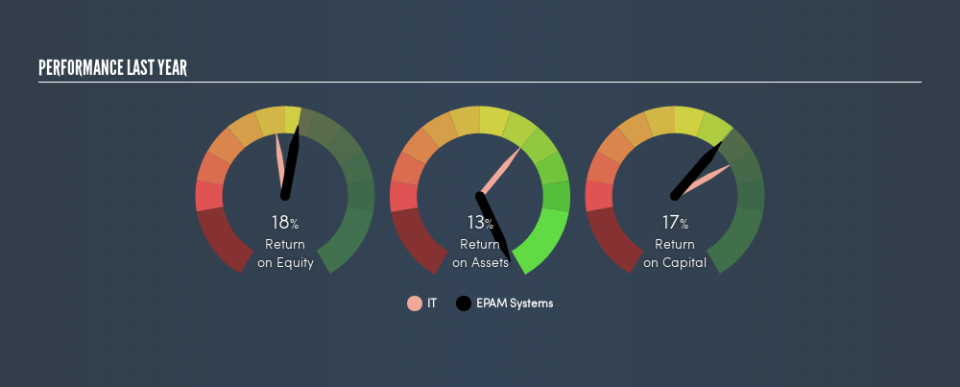What Can We Make Of EPAM Systems, Inc.’s (NYSE:EPAM) High Return On Capital?

Want to participate in a short research study? Help shape the future of investing tools and you could win a $250 gift card!
Today we'll evaluate EPAM Systems, Inc. (NYSE:EPAM) to determine whether it could have potential as an investment idea. To be precise, we'll consider its Return On Capital Employed (ROCE), as that will inform our view of the quality of the business.
First of all, we'll work out how to calculate ROCE. Second, we'll look at its ROCE compared to similar companies. Last but not least, we'll look at what impact its current liabilities have on its ROCE.
Understanding Return On Capital Employed (ROCE)
ROCE measures the amount of pre-tax profits a company can generate from the capital employed in its business. All else being equal, a better business will have a higher ROCE. In brief, it is a useful tool, but it is not without drawbacks. Renowned investment researcher Michael Mauboussin has suggested that a high ROCE can indicate that 'one dollar invested in the company generates value of more than one dollar'.
So, How Do We Calculate ROCE?
Analysts use this formula to calculate return on capital employed:
Return on Capital Employed = Earnings Before Interest and Tax (EBIT) ÷ (Total Assets - Current Liabilities)
Or for EPAM Systems:
0.17 = US$262m ÷ (US$1.8b - US$283m) (Based on the trailing twelve months to March 2019.)
Therefore, EPAM Systems has an ROCE of 17%.
View our latest analysis for EPAM Systems
Does EPAM Systems Have A Good ROCE?
When making comparisons between similar businesses, investors may find ROCE useful. In our analysis, EPAM Systems's ROCE is meaningfully higher than the 9.7% average in the IT industry. We consider this a positive sign, because it suggests it uses capital more efficiently than similar companies. Regardless of where EPAM Systems sits next to its industry, its ROCE in absolute terms appears satisfactory, and this company could be worth a closer look.
You can click on the image below to see (in greater detail) how EPAM Systems's past growth compares to other companies.
It is important to remember that ROCE shows past performance, and is not necessarily predictive. ROCE can be deceptive for cyclical businesses, as returns can look incredible in boom times, and terribly low in downturns. ROCE is, after all, simply a snap shot of a single year. Since the future is so important for investors, you should check out our free report on analyst forecasts for EPAM Systems.
What Are Current Liabilities, And How Do They Affect EPAM Systems's ROCE?
Liabilities, such as supplier bills and bank overdrafts, are referred to as current liabilities if they need to be paid within 12 months. The ROCE equation subtracts current liabilities from capital employed, so a company with a lot of current liabilities appears to have less capital employed, and a higher ROCE than otherwise. To counteract this, we check if a company has high current liabilities, relative to its total assets.
EPAM Systems has total assets of US$1.8b and current liabilities of US$283m. As a result, its current liabilities are equal to approximately 15% of its total assets. A fairly low level of current liabilities is not influencing the ROCE too much.
Our Take On EPAM Systems's ROCE
This is good to see, and with a sound ROCE, EPAM Systems could be worth a closer look. EPAM Systems looks strong on this analysis, but there are plenty of other companies that could be a good opportunity . Here is a free list of companies growing earnings rapidly.
I will like EPAM Systems better if I see some big insider buys. While we wait, check out this free list of growing companies with considerable, recent, insider buying.
We aim to bring you long-term focused research analysis driven by fundamental data. Note that our analysis may not factor in the latest price-sensitive company announcements or qualitative material.
If you spot an error that warrants correction, please contact the editor at editorial-team@simplywallst.com. This article by Simply Wall St is general in nature. It does not constitute a recommendation to buy or sell any stock, and does not take account of your objectives, or your financial situation. Simply Wall St has no position in the stocks mentioned. Thank you for reading.

